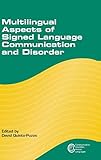Multilingual Aspects of Signed Language Communication and Disorder / ed. by David Quinto-Pozos.
Material type: TextSeries: Communication Disorders Across LanguagesPublisher: Bristol ; Blue Ridge Summit : Multilingual Matters, [2014]Copyright date: ©2014Description: 1 online resource (288 p.)Content type:
TextSeries: Communication Disorders Across LanguagesPublisher: Bristol ; Blue Ridge Summit : Multilingual Matters, [2014]Copyright date: ©2014Description: 1 online resource (288 p.)Content type: - 9781783091300
- 9781783091317
- 419 23
- P117 .M85 2014
- P117 .M85 2014
- online - DeGruyter
- Issued also in print.
| Item type | Current library | Call number | URL | Status | Notes | Barcode | |
|---|---|---|---|---|---|---|---|
 eBook
eBook
|
Biblioteca "Angelicum" Pont. Univ. S.Tommaso d'Aquino Nuvola online | online - DeGruyter (Browse shelf(Opens below)) | Online access | Not for loan (Accesso limitato) | Accesso per gli utenti autorizzati / Access for authorized users | (dgr)9781783091317 |
Frontmatter -- Contents -- Contributors -- Foreword -- Preface -- 1. Considering Communication Disorders and Differences in the Signed Language Modality -- Part 1: Developmental Language Disorders in the Signed Modality -- 2. Profiling SLI in Deaf Children who are Sign Language Users -- 3. A Case-study Approach to Investigating Developmental Signed Language Disorders -- 4. The Acquisition of Sign Language by Deaf Children with Autism Spectrum Disorder -- 5. Mapping Out Guidelines for the Development and Use of Sign Language Assessments: Some Critical Issues, Comments and Suggestions -- Part 2: Fluency Disorders, Neurogenics and Acquired Communication Disorders -- 6. A Review of Stuttering in Signed Languages -- 7. Sign Dysarthria: A Speech Disorder in Signed Language -- 8. The Influence of Dementia on Language in a Signing Population -- Part 3: Hearing Children from Signing Households -- 9. KODAs: A Special Form of Bilingualism -- 10. Language Development in ASL-English Bimodal Bilinguals -- Index
restricted access online access with authorization star
http://purl.org/coar/access_right/c_16ec
Inquiry into signed languages has added to what is known about structural variation and language, language learning, and cognitive processing of language. However, comparatively little research has focused on communication disorders in signed language users. For some deaf children, atypicality is viewed as a phase that they will outgrow, and this results in late identification of linguistic or cognitive deficits that might have been addressed earlier. This volume takes a step towards describing different types of atypicality in language communicated in the signed modality such as linguistic impairment caused by deficits in visual processing, difficulties with motor movements, and neurological decline. Chapters within the book also consider communication differences in hearing children acquiring signed and spoken languages.
Issued also in print.
Mode of access: Internet via World Wide Web.
In English.
Description based on online resource; title from PDF title page (publisher's Web site, viewed 24. Apr 2022)


